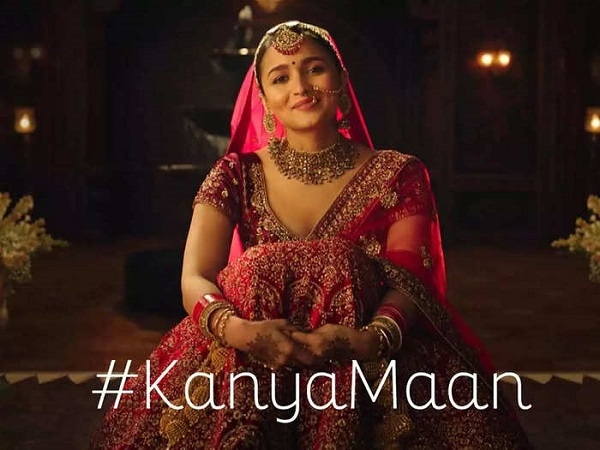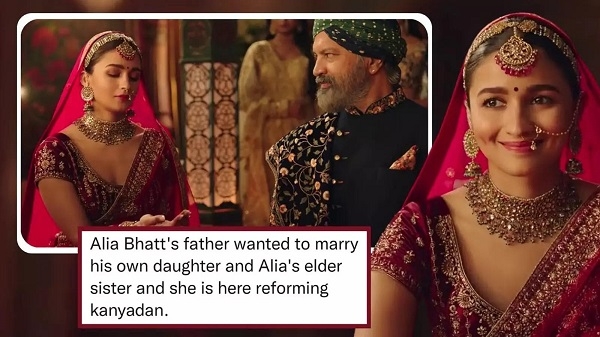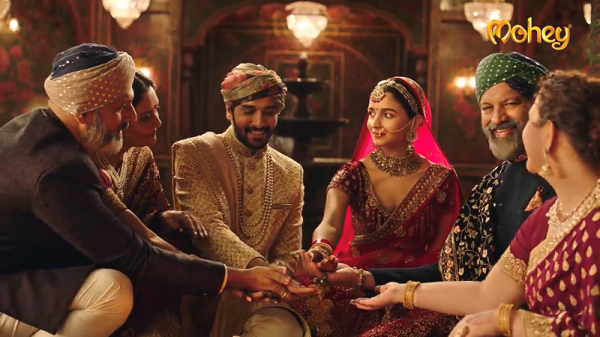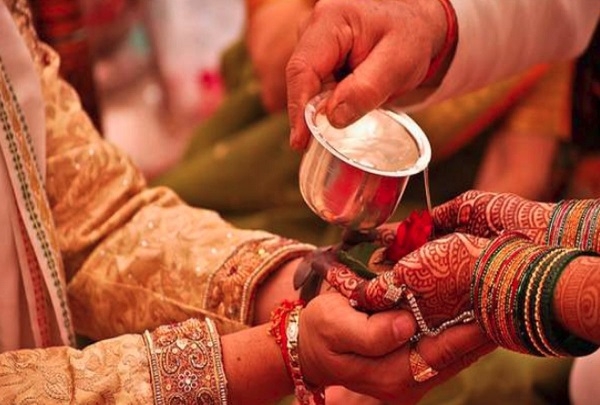Trending- Does Kanyadaan really mean donating our daughters?
The slavery and colonialism of many centuries has impacted our self-respect and while we, as a nation and society, work to shake it off and rebuild our narrative, misinformation such as this advertisement are all around us.
Total Views |
A new Indian television advertisement has become a hot topic among Indians. A bride ,in the midst of a traditional Hindu marriage ceremony, is giving a high-brow running commentary on the place of a woman in India, or more specifically, the Hindu society and the shameful treatment she gets from her parents and everyone else from early childhood, just because of her gender. She remembers how her parents always called her paraya dhan that translates as someone else’s wealth. Then she talks about a rite performed in the marriage ceremony called the Kanyadaan, something similar to how a father gives away the bride in a Christian wedding ceremony. She finds that rite abominable as it makes her feel like an object or a cow that her father owns and can give away at will. She also makes a highfalutin suggestion that the name of that rite should be changed from Kanyadaan to Kanyamaan, meaning it should not be called the giving away of the daughter but honouring the daughter. As the two words rhyme, it looks like a very smart and revolutionary solution to the shameful Hindu custom.

I don’t know much about the people behind this ad but it may not be too important. Let us assume for the sake of discussion that they have fair and honest intentions, have done their homework about these rites and Sanskrit words and they don’t have malicious misinformation about Hinduism as their agenda. Of course, don’t expect their next advertisement about the Christian wedding tradition of the father ‘giving away the bride’. There is a predictable pattern for such advertisements in today’s world controlled by super-large media companies that we will see a little bit about.
Then we will see the word Kanyadaan itself. This advertisement equates the word Kanyadaan with donation, gift, or charity. It certainly is one meaning of the word Daana but a very narrow one. Daana as a Sanskrit word, like many other Sanskrit words, has many meanings and nuances depending on the context that need to be understood. There is extensive discussion on this word in our Shastras and scholars have commented on the same for many millennia.
I am not qualified to discuss them in depth but will try to present some important references.
First, let us see the pattern of events following such an advertisement. Like we said earlier, let us assume that the creators of this ad have no malicious, anti-Hindu agenda. It will be shown repeatedly to hundreds of millions of Indians, they will promptly forward it on social media and praise it or curse it, making it more popular either way. The ad agency will submit the same in many competitions with the intent of getting more recognition, publicity and of course, more business. Now you may know there are just five to six advertising (or media, in the modern parlance) companies, such as WPP, Publicis, Omnicom, Dentsu and a few others, that control a very large part of this industry globally. In all probability, the agency that created this ad is owned by one of these (and if not, will soon be). In order to maintain that local feel and recognition, these companies usually don’t change the name of the companies they buy. For example, Chaitra is a very well-known Indian advertising agency, that is owned by an American company by the name of Leo Burnett, that is in turn owned by Publicis, one of the big five mentioned above. They are watching all their campaigns and they will sense the potential of this ad, and will see how they can take it to their world-wide audience, make it in multiple languages and even change it to suit other cultural contexts.
Thus, the themes such as the ill-treatment of a woman, from birth to death, in the Indian-Hindu society, her standing up against it or even rebelling will be played in every home around the world. It will be followed up by media campaigns, documentaries, conferences (such as the recent Dismantling Global Hindutva), and long articles and books by learned professors. These are all events in the normal flow of any business and one cannot say they should not take place but we need to know that they will unfold and contribute to the maligning of Indian and Hindu traditions, without fact-checking, and without knowledge, if we don’t respond firmly.

And this is not a prediction or clairvoyance of any kind, this is a well-established pattern of theglobal media industry as these few companies have acquired controlling interests worldwide. Now let us come to the true meaning of the word kanyadaan. Kanya means daughter, there are no nuances to it. But daan or daanam is a very complex word and it has been simplistically presented as a donation, gift, or charity in this advertisement. It certainly means that but it is just one, and a very narrow interpretation. Daan is a Sanskrit word that, like all other Sanskrit words, has many nuances and aspects that are context-based that we need to make an effort to understand. And the people who come from a confidence born-of-ignorance position or a deliberate-misinterpretation-to-slander position, usually proper study and fair representation are not their priorities, but twisting the meaning to suit their convenience is.
A great place to start is the sixteenth chapter of the Bhagvad Geeta has to say about daanam. The Lord explains the Daivi and Asuri attributes in this chapter. Deva is generally translated as god and Asura as demons in English and while we will not digress in this article, it is important to keep in mind both are completely wrong as they superimpose the western ideas of god and demon onto these words. Many scholars have interpreted and commented on the word Daan extensively over centuries and we can easily discern the following interpretations of this word.
One is that the person receiving the daan must want it or have a need for it. Giving food to a person with a full stomach is not considered daan. Second is that the entire universe, the prakruti or srushti, is owned by the Ishwar and we nourish our life with its bounty. So we don’t own anything and the idea of donating does not arise. A third meaning is that a daan can take many forms, not just money or objects measured in money as it is seen now. Being kind is a form of daan. Showing compassion to a person in a bad situation too is a daan and we understand the word daan only when we understand this broad concept.
Another important attribute of daan to know is that a daan is not limited to simply giving of an object but involves transmission of our thoughts, feelings, and desires along with it. This makes it imperative that we perform the act of daan with piety, gratitude, and blissfulness so both the giver and the recipient benefit from it. Another important condition is that when we give a daan, we should have no expectation of anything in return. There is nothing wrong with this but we have to realize that it is a transaction and not a daan. A daan should also have a material impact on the giver to qualify as a daan. If a billionaire gives 50,000 rupees to someone, it is not a daan, it will qualify the word donation that this advertisement alludes to. There are many more nuances of this word but I guess this gives you a good idea of the depth of this word and why we should not get swayed by the narrow, twisted interpretations in frivolous media. But the Lord knows performing a daankarma that meets all these criteria will be difficult for ordinary people. People will perform a daan only to meet their own needs, desires and selfish interests. So the Lord says more about daan in the 17th chapter again. He explains the three types of daanas, their symbols and consequences. The first type is called the saatvik daan. It is symbolized by the giver giving the same with a sense of duty and not as a favour. The giver’s position is that she or he received a lot from the universe that made their life possible and pleasant. Therefore, it is their duty to try their best to give back to the universe as much as they can.
This is perhaps the best example of a true ecosystem that enables a mutually supporting and nourishing environment for all of creation. The thought in Kanyadaan is that when I was looking to start my grihasthashram, some parents, that had nurtured and protected their daughter will all their love, allowed me to marry their daughter that made my grihasthashram possible and successful so now it is my turn to allow my daughter and a would-be grihastha to start their life together.

Of course, some modern, liberal may question this by claiming you are treating your daughter as a lamb or a flower-plant when you say you brought her up. It will be difficult to answer such questions as we human beings, as parents or in any other role, can neither make a plant grow, nor a lamb, and certainly not our daughter. They all grow as their natural progression as a life and we can, at best, help them along. Another characteristic of the saatvik daan is that it must not be returning a previous gift or given with the intention of receiving something back. There is nothing wrong with these except that they should be understood as transactions, and not daan. A saatvik daan is also characterized by appropriateness of place, time, and recipient’s worthiness. Most of our giving is oriented to meeting our own needs and desires. It could be fame, recognition, and respect in society. Or family welfare, or placating someone that can cause you harm in some manner etc. This type of daan causes anxiety as you have to constantly calculate the balance of what you give verus what you receive and strive to keep the balance in your favour.
This is called the Raajas daan. For example, a king or a rich person donates many things to many people to gain respect, prominence, loyalty, and a good name. Or even, to erase the ill reputation they suffer from. Similarly, when it is time to arrange the marriage of a young son or daughter, the king will scrutinize all the kings surrounding his kingdom to decide which of them will be the most beneficial to his power and wealth. With a marital relationship established, he can expect the support of that king to maybe attack or checkmate another king that is a threat, or protect himself from a more powerful adversary by joining forces with the king that becomes his extended family now. Again, these are all perfectly fine actions for a person playing a certain role in his or her life but we need to remember for what it is and not think of it as a saatvik daan. The third type is described as Taamas daan whose principal characteristic is thoughtlessness or wantonness. There is no thought about the place, the time, if the recipient is worthy or deserving of the daan. Another sign is that it is given in a very callous, insulting manner without an appropriate ceremony or dignity. The best example we all know is how King Dhanandanda treated the visiting scholars, including Chanakya, in his court and we also know the consequences he had to suffer.Scholars have commented extensively on the concept of daan and we can see many more examples.

But I am sure you got a very good idea of the concept behind the original Sanskrit word through these examples from the Bhagwad Geeta. The slavery and colonialism of many centuries has impacted our self-respect and while we, as a nation and society, work to shake it off and rebuild our narrative, misinformation such as this advertisement are all around us. They are presented in a sleek, shiny, and intellectually titillating manner and it is very easy to get swayed by them. Our younger generations, perhaps not well-versed in our culture and traditions, are particularly vulnerable. Many young girls have said or will say, to their parents not to perform their kanyadaan ceremony during their marriage rites, calling it a despicable custom. Many parents, out of their own ignorance or the desire not to escalate disagreement with their daughter, acquiesce to their daughter’s demand. While picking and choosing rites out of a holistic ceremony is not a good idea, it is perhaps fair to say that everyone has a right to determine what rites they want to perform. But that determination should be based on knowledge of the rite’s intent, meaning, and purpose and not picked up from such advertisements and other shallow and malicious media campaigns.
.
.
